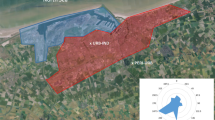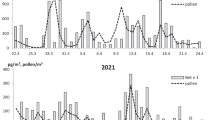Abstract
Oak pollen is a major respiratory allergen in Korea, and the distribution of oak trees is expected to increase by ecological succession and climate change. One of the drivers of climate change is increasing CO2, which is also known to amplify the allergy risk of weed pollen by inducing elevated allergenic protein content. However, the impact of CO2 concentration on tree pollen is not clearly understood due to the experimental difficulties in carrying out extended CO2 treatment. To study the response of pollen production of sawtooth oak trees (Quercus acutissima) to elevated levels of ambient CO2, three open-top chambers at the National Institute of Forest Science in Suwon, Korea were utilized with daytime (8 am–6 pm) CO2 concentrations of ambient (× 1.0, ~ 400 ppm), × 1.4 (~ 560 ppm), and × 1.8 (~ 720 ppm) treatments. Each chamber had three sawtooth oak trees planted in September 2009. One or two trees per chamber matured to bloom in 2016. Five to six catkins were selected per tree and polyethylene bags were attached to collect pollen grains. The total number of catkins per tree was counted and the number and weight of pollen grains per catkin were measured. Oak allergen—Que a 1 (Allergon Co., Uppsala, Sweden)—was extracted and purified to make an ELISA kit by which the antigen levels in the pollen samples were quantified. Total pollen counts per tree of the × 1.4 and × 1.8 treatments showed significant increase of 353 and 1299%, respectively, from the × 1.0 treatment (p < 0.001). Allergenic protein contents at the × 1.4 and × 1.8 treatments also showed significant increase of 12 and 11%, respectively (p = 0.011). The × 1.8 treatment induced significant difference from the × 1.0 treatment in terms of pollen production and allergenic protein content, whereas the × 1.4 treatment showed mixed significance. In summary, the oak trees under the elevated CO2 levels, which are expected in the changing climate, produced significantly higher amount of pollen and allergenic protein than under the present air conditions.




Similar content being viewed by others
References
Ackerly DD, Bazzaz FA (1995) Plant growth and reproduction along CO2 gradients: non-linear responses and implications for community change. Glob Chang Biol 1:199–207
Albertine JM, Manning WJ, DaCosta M, Stinson KA, Muilenberg ML, Rogers CA (2014) Projected carbon dioxide to increase grass pollen and allergen exposure despite higher ozone levels. PLoS One 9:e111712
Anenberg SC, Weinberger KR, Roman H, Neumann JE, Crimmins A, Fann N, Martinich J, Kinney PL (2017) Impacts of oak pollen on allergic asthma in the United States and potential influence of future climate change. GeoHealth 1:80–92
Beggs PJ (2004) Impacts of climate change on aeroallergens: past and future. Clin Exp Allergy 34:1507–1513
Bianchi DE, Schwemmin DJ, Wagner WH Jr (1959) Pollen release in the common ragweed (Ambrosia artemisiifolia). Bot Gaz 120:235–243
Boavida LC, Silva JP, Feijo JA (2001) Sexual reproduction in the cork oak (Quercus suber L). II. Crossing intra- and interspecific barriers. Sex Plant Reprod 14:143–152
Bradford MM (1976) A rapid and sensitive method for the quantitation of microgram quantities of protein utilizing the principle of protein-dye binding. Anal Biochem 72:248–254
Choung Y, Lee B-C, Cho J-H, Lee K-S, Jang I-S, Kim S-H, Hong S-K, Jung H-C, Choung H-L (2004) Forest responses to the large-scale east coast fires in Korea. Ecol Res 19:43–54
Deng X, Woodward FI (1998) The growth and yield responses of Fragaria ananassa to elevated CO2 and N supply. Ann Bot 81:67–71
Emberlin J, Mullins J, Corden J, Jones S, Millington W, Brooke M, Savage M (1999) Regional variations in grass pollen seasons in the UK, long-term trends and forecast models. Clin Exp Allergy 29:347–356
Fann N, Brennan T, Dolwick P, Gamble JL, Ilacqua V, Kolb L, Nolte CG, Spero TL, Ziska L (2016) Ch. 3: air quality impacts. In: The impacts of climate change on human health in the United States: a scientific assessment. U.S. Global Change Research Program, Washington, D.C., pp 69–98. https://doi.org/10.7930/J0GQ6VP6
García-Mozo H, Galán C, Belmonte J, Fernández D, Rodriguez FJ (2002) Modelling start of oak pollen season in different climatic zones in Spain. Agric For Meteorol 110:247–257
IPCC (2013) Summary for policymakers. In: Stocker TF, Qin D, Plattner G-K, Tignor M, Allen SK, Boschung J, Nauels A, Xia Y, Bex V, Midgley PM (eds) Climate change 2013: the physical science basis. Contribution of working group I to the fifth assessment report of the intergovernmental panel on climate change. Cambridge University Press, Cambridge, United Kingdom
Iverson LR, Prasad AM, Matthews SN, Peters M (2008) Estimating potential habitat for 134 eastern US tree species under six climate scenarios. For Ecol Manag 254:390–406
Jeong SJ, Medvigy D, Shevliakova E, Malyshev S (2012) Uncertainties in terrestrial carbon budgets related to spring phenology. J Geophys Res 117:G01030. https://doi.org/10.1029/2011JG001868
Kremer A, Petit RJ (1993) Gene diversity in natural populations of oak species. Ann For Sci 50:186s–202s
Kuribayashi M, Noh N-J, Saitoh TM, Ito A, Wakazuki Y, Muraoka H (2017) Current and future carbon budget at Takayama site, Japan, evaluated by a regional climate model and a process-based terrestrial ecosystem model. Int J Biometeorol 61:989–1001
Lee J-C, Kim D-H, Kim GN, Kim P-G, Han S-H (2012) Long-term climate change research facility for trees: CO2-enriched open top chamber system. Korean J Agric For Meteorol 14:19–27
Lee JY, Yang M, Jeong KY, Sim DW, Park JH, Park KH, Lee JH, Park JW (2017) Characterization of major allergen from Mongolian oak, Quercus mongolica, a dominant species of oak in Korea. Int Arch Allergy Immunol 174:77–85
Moser A, Rahman MA, Pretzsch H, Pauleit S, Roetzer T (2017) Inter- and intraannual growth patterns of urban small-leaved lime (Tilia cordata mill.) at two public squares with contrasting microclimatic conditions. Int J Biometeorol 61:1095–1107
NOAA/ESRL. (2017) Trends in atmospheric carbon dioxide. http://www.esrl.noaa.gov/gmd/ccgg/trends/. Accessed 29 June 2017
Oh JW, Lee HB, Kang IJ, Kim SW, Park KS, Kook MH, Kim BS, Baek HS, Kim JH, Kim JK, Lee DJ, Kim KR, Choi YJ (2012) The revised edition of Korean calendar for allergenic pollen. Allergy, Asthma Immunol Res 4:5–11
Reid CE, Gamble JL (2009) Aeroallergens, allergic disease, and climate change: impacts and adaptation. EcoHealth 6:458–470
Rogers CA, Wayne PM, Macklin EA, Muilenberg ML, Wagner CJ, Epstein PR, Bazzaz FA (2006) Interaction of the onset of spring and elevated atmospheric CO2 on ragweed (Ambrosia artemisiifolia L.) pollen production. Environ Health Perspect 114:865–869
Ryu D, Bae J, Park J, Cho S, Moon M, Oh C-Y, Kim HS (2014) Responses of native trees species in Korea under elevated carbon dioxide condition—open top chamber experiment. Korean J Agric For Meteorol 16:199–212
Seo D-J, Oh C-Y, Han S-H, Lee J-C (2014) Effects of elevated CO2 concentration on leaf phenology of Quercus acutissima. Korean J Agric For Meteorol 16:213–218
Schmidt CW (2016) Pollen overload seasonal allergies in a changing climate. Environ Health Persp 124:A71–A75
Shao G (1996) Potential impacts of climate change on a mixed broadleaved-Korean pine forest stand: a gap model approach. Clim Chang 34:263–268
Sheffield PE, Weinberger KR, Ito K, Matte TD, Mathes RW, Robinson GS, Kinny PL (2011a) The association of tree pollen concentration peaks and allergy medicine sales in New York City: 2003–2008. Inter Schol Res Net ISRN Allergy 2011:1–7. https://doi.org/10.5402/2011/537194
Sheffield PE, Weinberger KR, Kinny PL (2011b) Climate change, aeroallergens and pediatric allergic disease. Mt Sinai J Med 78:78–84
Singer BD, Ziska LH, Frenz DA, Gebhard DE, Straka JG (2005) Increasing Amb a 1 content in common ragweed (Ambrosia artemisiifolia) pollen as a function of rising atmospheric CO2 concentration. Funct Plant Biol 32:667–670
Wayne P, Foster S, Connolly J, Bazzaz F, Epstein P (2002) Production of allergenic pollen by ragweed (Ambrosia artemisiifolia L.) is increased in CO2-enriched atmospheres. Ann Allergy Asthma Immunol 88:279–282
Whittemore AT (2004) Sawtooth oak (Quercus acutissima, Fagaceae) in North America. SIDA, Contributions to Botany 21:447–454
Zhang Y, Bielory L, Georgopoulos PG (2014) Climate change effect on Betula (birch) and Quercus (oak) pollen seasons in the United States. Int J Biometeorol 58:909–919
Ziska LH, Beggs PJ (2012) Anthropogenic climate change and allergen exposure: the role of plant biology. J Allergy Clin Immunol 129:27–32. https://doi.org/10.1016/j.jaci.2011.10.032
Ziska LH, Caulfield FA (2000) Rising CO2 and pollen production of common ragweed (Ambrosia artemisiifolia), a known allergy-inducing species: implications for public health. Aust J Plant Physiol 27:893–898
Acknowledgments
The authors thank the anonymous reviewers, who gave valuable comments for the improvement of the manuscript.
Funding
This research was supported by the “Research and Development for KMA Weather, Climate, and Earth system Services” of the National Institute of Meteorological Sciences (NIMS) of the Korea Meteorological Administration (KMA).
Author information
Authors and Affiliations
Corresponding author
Electronic supplementary material
ESM 1
(XLSX 75 kb)
Rights and permissions
About this article
Cite this article
Kim, K.R., Oh, JW., Woo, SY. et al. Does the increase in ambient CO2 concentration elevate allergy risks posed by oak pollen?. Int J Biometeorol 62, 1587–1594 (2018). https://doi.org/10.1007/s00484-018-1558-7
Received:
Revised:
Accepted:
Published:
Issue Date:
DOI: https://doi.org/10.1007/s00484-018-1558-7




